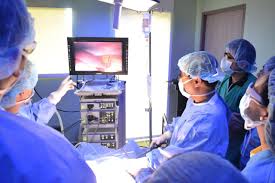One of the greatest evolutions in medical science, and definitively the greatest in General Surgery during the 20th century, is Laparoscopic Surgery. With laparoscopy, the surgeon performs surgical operations through small holes using special tools, while he sees magnified the internal organs of the patient with the use of a very thin camera. It has been developed mainly the last two decades with the use of optic fibres, modern biomedical technology, surgical laser and video technology.
In 1987, the year that the first experimental laparoscopic cholecystectomy was performed by Mouret, was the beginning of the technological revolution in Surgery. Since then, a series of pioneer doctors applied laparoscopic surgery in many surgical procedures, gradually obtaining valuable experience and skill, so nowadays we are able to claim that experienced laparoscopic teams can perform almost every operation with the laparoscopic technique.


Advantages of laparoscopic surgery
The application of laparoscopic surgery offers the patients plenty important advantages:
- Application of “minimally invasive surgery”
- Very small incisions through which we minimise the surgical trauma
- Minimising postsurgical pain.
- Excellent aesthetic result, since practically there are no scars after the operation.
- Faster recovery and hospital discharge.
- Less hospital cost and faster recovery and return to work.
- 10 to 15 times magnification, achieving minimum tissue damage and blood loss.
- Lack of post-surgical complications related to the surgical wound, such as infections, herniation, chronic pain etc.
- Fewer respitory and cardiovascular complications.
- Great reduction of the possibility of post-surgical adhesions creation.
- The patient is protected by the transmission of diseases (hepatitis, AIDS), since the tools are of a single use.
Applications of Laparoscopic Surgery
Today’s applications of laparoscopic surgery have been expanded in a broad spectrum of surgical procedures, including both simple and more complex procedures:
-
- Laparoscopic treatment of inguinal hernia, post-surgical hernia, epigastric hernia, umbilical hernia etc.
- Laparoscopic treatment of varicocele
- Laparoscopic appendicectomy.
- Laparoscopic treatment of peptic ulcer.
- Laparoscopic treatment of ileus and adhesions.
- Laparoscopic cholecystectomy and bile duct exploration.
- Laparoscopic drainage of intra-abdominal abscess.
- Laparoscopic removal of extra-uterus pregnancy.
- Laparoscopic ovariectomy, ovarian-cyst excision and treatment of endometriosis.
- Laparoscopic excision of uterus fibromyomas and total hysterectomy.
- Laparoscopic gastrectomy.
- Laparoscopic enterectomy and colectomy, both for malignant (cancer) and benign diseases (diverticular disease, polyps, ulcerative colitis etc.)
- Diagnostic laparoscopy with biopsies for the diagnosis of several diseases and staging of abdominal cancers.
- Laparoscopic excision of mesenteric cysts.
- Laparoscopic partial hepatectomy and liver metastases excision.
- Laparoscopic RF(radiofrequency) application for liver tumors.
- Laparoscopic excision of hydatid cysts (echinococcus).
- Laparoscopic pancreatectomy.
- Laparoscopic treatment of morbid obesity with placement of gastric bandage, sleeve gastrectomy and gastric bypass.
- Laparoscopic treatment of hiatal hernia and gastroesophageal reflux disease.
- Laparoscopic treatment of esophageal achalasia.
- Laparoscopic excision of renal cysts and tumors.
- Laparoscopic adrenalectomy.
- Laparoscopic splenectomy.
- Laparoscopic treatment of hydrocephaly.


